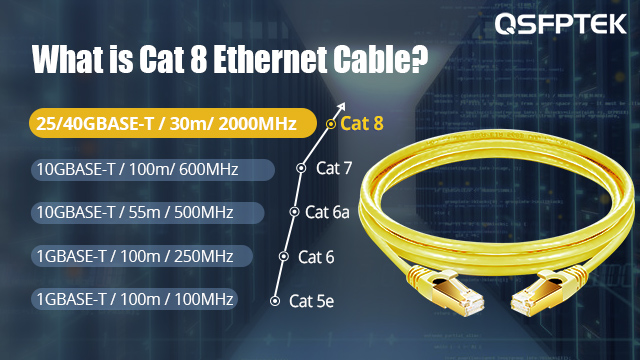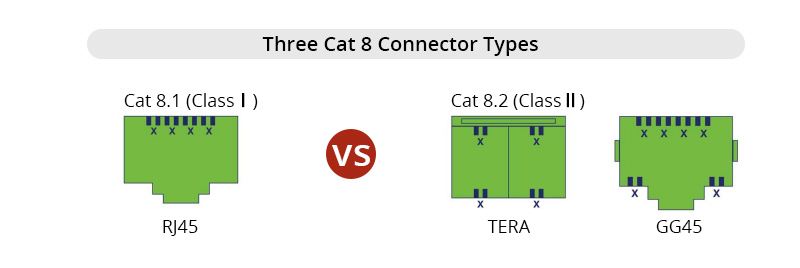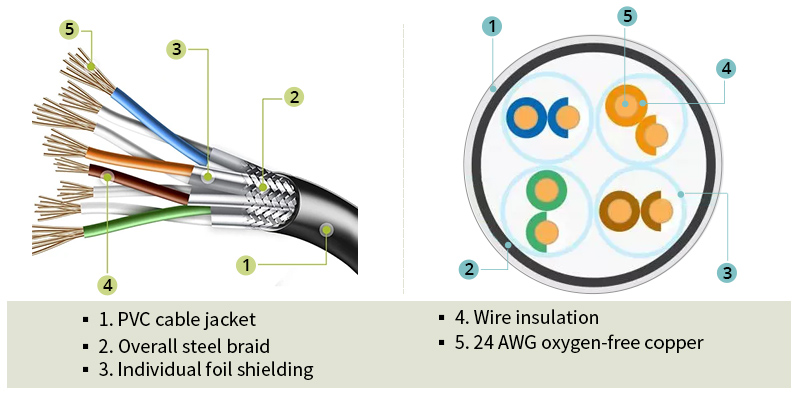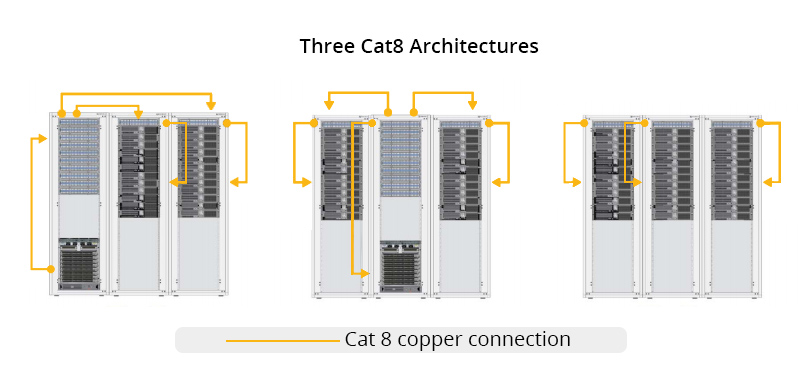Cat 8 Ethernet Cable Wiki with FAQs
In the previous post, we have introduced and compared the four common Ethernet copper cables of Cat5e vs Cat6 vs Cat6a vs Cat7. Then, how about Cat8. What is Cat8? What are the advantages of Cat8? Is Cat8 better than the previous type of Cat5 to Cat7? Does it have limitations? Is it backward compatible? What are the differences between Cat 5 vs Cat 6 vs Cat 7 vs Cat 8? Should I use a Cat8 cable? This article will answer these questions one by one.
What is Cat 8 Ethernet Cable?
Category 8 (Cat 8) is the newest standard in Ethernet copper network cabling, specified and released by ANSI/TIA 568. 2016 is Cat 8 release date. Cat 8 cable with next-gen features becomes the latest iteration of the Ethernet cable category.

One thing that should note here is that there are different standards of Cat 8 Ethernet cable. Because ISO SC25 WG3 developed the original standard to ISO/IEC 11801-1:2017/COR 1:2018, providing two options for Cat8 — ClassⅠchannel Cat 8.1 vs Class Ⅱ channel Cat 8.2.
▪ Cat8.1 Ethernet cable uses RJ45 connectors, so as to be compatible with Cat6a and previous Ethernet cables.
▪ Cat8.2 Ethernet cable uses non-RJ45 connectors, specifically is TERA or GG45, aiming to interoperate with Cat7 cables.

Fig 1: Cat 8 connectors - ClassⅠCat 8.1 vs Class Ⅱ Cat 8.2
The basic Cat8 specification is shown in the table below.
Cat 5 vs Cat 6 vs Cat 7 vs Cat 8 Ethernet Cable Comparison
To better understand the difference between Cat 5 vs Cat 8, Cat 6 vs Cat 8, and Cat 7 vs Cat 8, first, let’s have an overview of each cable category.
Cat 5 vs Cat 8, What is Cat5?
Category 5 cable (Cat 5), as the successor of Cat 3, was published in 1995. Latter the enhanced version Cat 5e was introduced in 2001, since which Cat 5e has become the most frequently used copper cable. It supports a max bandwidth up to 100 MHz at 1 Gbps within 100 meters.
Cat 6 vs Cat 8, What is Cat6?
Category 6 cable (Cat 6) as an advanced version of Cat5e was published in 2001. It has developed into upgraded versions: Cat6a and Cat6e. Cat 6a supports a max bandwidth up to 500 MHz at 10 Gbps within 55 meters. The difference between cat 6 and cat 8 mainly lies in transmission performance.
Cat 7 vs Cat 8, What is Cat7?
Category 7 cable (Cat 7) was ratified by ISO/IEC 11801 in 2002 as a Class F channel. It utilizes GG45 or TERA connectors, non-RJ45 connectors. It has a max bandwidth of 600 MHz at 10Gbps within 100 meters.
The table below shows the differences and identicality between Cat 5 vs Cat 6 vs Cat 7 vs Cat 8 Ethernet cable specification and features.
Taking Cat7 vs Cat8 comparison as an example, we can figure out the following information:
Similarity:
▪ Shielding — Both Cat7 and Cat8 are shielded cables. Therefore they have stricter requirements for crosstalks and noise resistance and own a better ability to anti Electromagnetic interference (EMI).
Differences:
▪ Connector — Cat7 cable utilizes GG45 or TERA connectors, Cat 8 cables have two standards, thus ordinary RJ45 Cat 8 connector and non-RJ45 connectors are available.
▪ Connector Pairs — Cat7 has four twisted copper wire pairs, Cat8 comes with two twisted pairs. Cat 7 has excellent advantages in noise assistance.
▪ Bandwidth — Cat7 is defined up to 600 MHz, while Cat8 supports a transmission frequency of 2000 MHz.
▪ Data rate — Cat7 max speed is 10Gbps, Cat 8 speed up to 25 Gbps/ 40Gbps.
▪ Distance — Cat7 can reach up to 100m at 10Gbps, Cat8’s max length is only 30m.
▪ Cost — Cat8 is the most expensive, cost more than Cat7 and previous cable categories.
What Makes the Best Cat 8 Ethernet Cable?
Cat 8 Ethernet cable owns the highest performance, mainly lies in the following factors: Cat 8 speed, Cat 8 bandwidth, Cat 8 PoE, crosstalk and signal interference ability, and etc. It is these features that make it count for high-speed networking and cutting-edge LANs.
The advantages and features that set Cat8 from other categories are listed below.
Cat8 Speed & Bandwidth
Cat8 bandwidth defines that it supports up to 2000MHz, four times that of the best Cat6 can reach. Cat8 speed ranges between 2500Mbps to 40000Mbps, whereas Cat6a can only run up to 10000Mbps.
Optimized Shielding Structure
Cat8 comes with Cat 8 SFTP (Shielded and Foiled Twisted Pair). The best Cat 8 Ethernet cable in the market utilizes a smaller 24AWG gauge (larger diameter), individual wire insulation, foil shielding, and steel braided shielding to ensure less resistance and the best shielding functions. Best shielding technology guarantees the highest capability to anti crosstalk and signals interference and attenuation.

Fig 2: Cat8 cable construction
PoE Capability
Cat 8 Ethernet cable supports Power over Ethernet (PoE) capability, which allows the PoE enabled devices (such as PoE switches) to supply power over a single Cat8. Cat 8 PoE ability gets rid of the trouble of extra power cables, delivering neat and well-managed structured cabling systems.
Restrictions of Cat 8 Ethernet Cable
Cat8 max length limits within 30m (98ft). Although most network cables are used within 25 feet, it is indeed reduced by a lot compared with the previous Ethernet cable categories. Cat8 distance limitation is shown in the picture below.

Fig 3: Cat5e/6/6a/7 vs Cat8 max length limit
Is Cat8 Backwards Compatible?
It depends. Cat 8 compatibility is quite different by whether it is Class Ⅰchannel Cat 8.1 cable or Class Ⅱ Cat 8.2 cable.
Cat 8.1 Ethernet cable adopts 8P8C connectors, therefore it is fully backward compatible with the previous ones such as Cat 6 cables using the same RJ45 connectors.
Cat 8.2 Ethernet cable utilizes non-RJ45 GG45 or TERA connectors, which are identical with Category 7 cable, hence it can interoperate with Cat 7.
Is Cat 8 Ethernet Cable Good for Gaming?
For game lovers, a smoother internet experience is always their pursuit. To ensure reliable network performance, a wired network connection in contrast to a trouble-prone wireless network is the best choice. Cat 8 cable, as the copper cable with the fastest speed so far in wired networks, hence be noticed by the online gaming industry. What follows is that the Cat 8 Ethernet cable for gaming has become a hot topic on the internet. Is Cat8 good for gaming? From the point of view of data speed, it obviously excellent, up to 25Gbit/s or even 40Gbit/s. If your network base such as the desktop gaming computer does works with the Cat8, then yes, you will have an unparalleled smooth gaming experience.
Is Cat8 Worth It? When to Choose Cat 8 Ethernet Cable?
Cat 8 Ethernet cable is not recommended in most scenarios. Say, Cat 8 home networks and small to medium businesses (SMBs) are quite a luxury. On the one hand, the Cat8 25G/40G data rate access is unnecessary for home and SMB use in most cases. On the other hand, deploying Cat 8 Ethernet cables requires the existing networking Infrastructure compatible with Cat8 cabling, or one needs to upgrade the networking equipment and devices to support Cat 8. However, the high upgrade cost outweighs the benefits of extreme speed. Hence, the Cat 8 cable for home networks and SMBs are not popular currently. Picking cheaper and just-right Cat6a can meet the requirement for higher-performance home and small business network use, such as intermediate 2.5GbE, 5GbE, and 10GBASE-T.
The utmost speed, other high-performance features make Cat 8 Ethernet cable cater for high-speed data centers and servers rooms where copper connection distance between servers and switches is short. Small to medium data centers seeking for 25G upgrade from 10G or 1G at the edge will especially be ideal for deploying Cat8 cabling. Since most large data centers might already be at 40G and fiber cabling has been deployed.

Fig 4: Three Cat 8 architectures for the switch to server connections at data center edge
Some experts also forecast the next few years will see the Cat8 cable demand increase. With the deployment of cutting-edge techs such as Cloud computing, 5G, and ever-increasing massive data traffic from the Core, Cat8 might be a go-to solution for a cheaper and scalable copper cabling system as an alternative to upgrading to 40G/100G fiber cabling.
Google Fiber has tried hard to make fiber optics for home use to achieve ubiquitous and fastest network connection. QSFPTEK provides fiber optic cables and structured cabling solutions. Any questions to consult or wanner to get a quote for wholesale prices, please contact us via [email protected].











